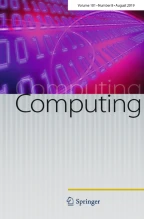Abstract
The solution of population balance equations is a function f(t,r,x) describing a population density of particles of the property x at time t and space r. For instance, the additional independent variable x may denote the particle size. The describing partial differential equation contains additional sink and source terms involving integral operators. Since the coordinate x adds at least one further dimension to the spatial directions and time coordinate, an efficient numerical treatment of the integral terms is crucial. One of the more involved integral terms appearing in population balance models is the coalescence integral, which is of the form ∫
0
x
κ(x–y, y) f(y) f(x–y)dy. In this paper, we describe an evaluation method of this integral which needs only operations, where n is the number of degrees of freedom with respect to the variable x. This cost can also be obtained in the case of a grid geometrically refined towards x=0.
Similar content being viewed by others
Explore related subjects
Discover the latest articles, news and stories from top researchers in related subjects.References
D. Braess W. Hackbusch (2005) ArticleTitleApproximation of 1/x by exponential sums in [1, ∞) IMA J. Numer. Anal. 25 685–697 Occurrence Handle1082.65025 Occurrence Handle2170519 Occurrence Handle10.1093/imanum/dri015
S. K. Friedlander (2000) Smoke, dust, and haze. Fundamentals of aerosol dynamics EditionNumber2 Oxford University Press New York
Hackbusch, W.: Entwicklungen nach Exponentialsummen. Technischer Bericht 4, Max-Planck-Institut für Mathematik, Leipzig 2005.
C. D. Immanuel F. J. Doyle (2003) ArticleTitleComputationally efficient solution of population balance models incorporating nucleation, growth and coagulation: Application to emulsion polymerization Chem. Engng. Sci. 58 3681–3698 Occurrence Handle10.1016/S0009-2509(03)00216-1
P. C. Kapur (1972) ArticleTitleKinetics of granulation by non-random coalescence mechanism Chem. Engng. Sci. 27 1863–1869 Occurrence Handle10.1016/0009-2509(72)85048-6
Koch, J.: Effiziente Behandlung von Integraloperatoren bei populationsdynamischen Modellen. Doctoral thesis, Universität Magdeburg 2005.
A. K. Louis P. Maaß A. Rieder (1998) Wavelets Teubner Stuttgart Occurrence Handle0897.42018
Niemann, B., Mahoney, A. W., Sundmacher, K.: Two-dimensional PDF model of chemical reactions in liquid-liquid dispersions. In: Population balance modelling 2004 (Nopens, I., Malisse, K., Biggs, C., Ducoste, J., eds.). Valencia 2004, pp. 133–136.
Peglow, M.: Beitrag zur Modellbildung von eigenschaftsverteilten dispersen Systemen am Beispiel der Wirbelschicht-Sprühagglomeration. Doctoral thesis, Universität Magdeburg 2005.
D. Ramkrishna (2000) Population balances. Theory and applications to particulate systems in engineering Academic Press San Diego
H. Struchtrup M. Luskin M. R. Zachariah (2001) ArticleTitleA model for kinetically controlled internal phase segregation during aerosol coagulation J. Aerosol Sci. 32 1479–1504 Occurrence Handle10.1016/S0021-8502(01)00068-4
Author information
Authors and Affiliations
Corresponding author
Rights and permissions
About this article
Cite this article
Hackbusch, W. On the Efficient Evaluation of Coalescence Integrals in Population Balance Models. Computing 78, 145–159 (2006). https://doi.org/10.1007/s00607-006-0174-2
Received:
Revised:
Published:
Issue Date:
DOI: https://doi.org/10.1007/s00607-006-0174-2
